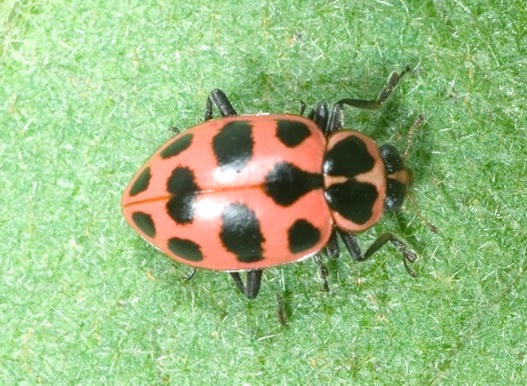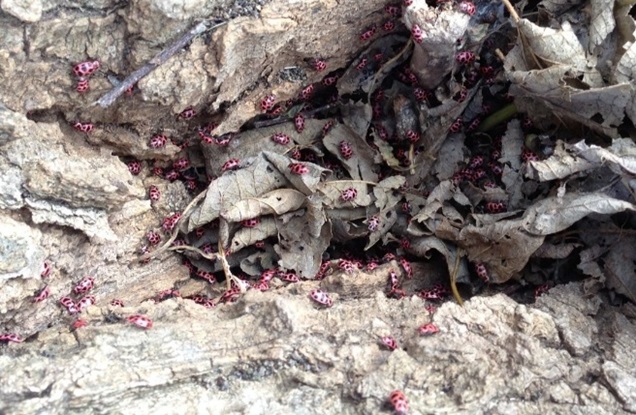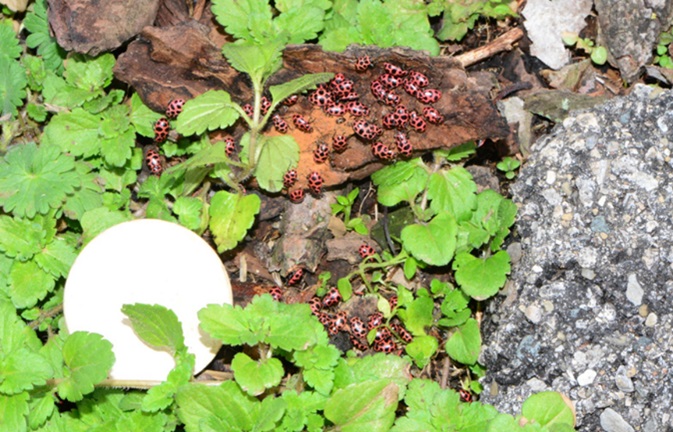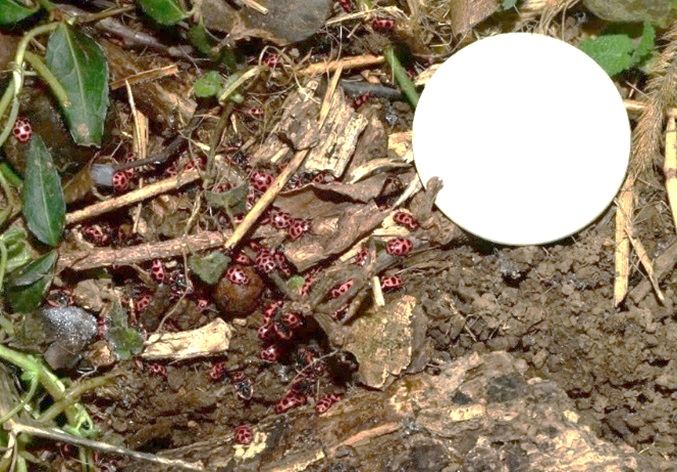Conserving Overwintering Habitats to Enhance Populations of Pink Spotted Ladybeetle
ENTFACT-713: Conserving Overwintering Habitats to Enhance Populations of Pink Spotted Ladybeetle | Download PDF
by jessica bessin (Horticulture Extension Agent in Mercer County), ric bessin (extension entomologist), and john obrycki (professor emeritus)
University of Kentucky College of Agriculture
Fast Facts
- The pink spotted ladybeetle (PSLB) feeds on many economically important insect pests.
- Adult PSLB overwinter in aggregations in leaf litter at the base of prominent trees in field margins.
- Growers can encourage populations of PSLB by leaving large trees (approx. 50 feet tall) within field margins.
- Small patches of winter-annual plants near the base of these trees provide food for the PSLB in early spring.
- Diverse field margins not only enhance beneficial predators like the PSLB, but also provide floral resources for pollinators
The pink spotted ladybeetle (Coleomegilla maculata) (PSLB), a native species, is widely distributed in eastern North America and can be found throughout Kentucky (Fig. 1). Larvae and adults feed on sweet corn pests, including corn leaf aphid and eggs and larvae of European corn borer. In potatoes, PSLB feeds on eggs and first instars of Colorado potato beetle and green peach aphid; in sorghum and wheat, it preys upon several aphid species. One unique aspect of PSLB is that almost half of its diet consists of pollen, nectar, and fungi, while the other half is made up of small arthropods.

This information is based on a two-year field study conducted by J. Bessin at the University of Kentucky North Farm in Lexington, Kentucky. This information helps growers conserve and/or attract this beneficial predatory species to their properties. The important message is that growers should consider leaving larger trees, surrounded by a small area of leaf litter and winter annual plants, within their field margins for potential overwintering sites for adult PSLB.
PSLB adults overwinter in aggregations commonly at the base of large, isolated trees along field margins. In central Kentucky, adults begin to gather at the base of trees in early October and tend to disperse into adjacent fields by mid-April. When PSLB aggregate at the base of a tree they appear to prefer areas where leaf litter had accumulated (Fig 2). The type of tree did not influence where PSLB chose to overwinter. At the study site, trees selected for overwintering sites by PSLB adults included species within seven different genera; oak, ash, maple, walnut, hackberry, hickory, and sycamore. If a tree is used as an overwintering site in one year, there is a very high probability (85%) that PSLB will select that tree for overwintering the following year.

During the winter and early spring, when temperatures increase above 40°F, PSLB become active, often moving away from the base of the tree into winter-annual plants around the tree. Larger aggregations of adult PSLBwere observed in association with trees with winter-annual plants found at their base (e.g., henbit, purple deadnettle, common chickweed, speedwell and ivyleaf speedwell). Winter annuals have a one-year life cycle, germinating from seed in late summer or early fall. Young plants live through the winter then flower, set seed, and die in late spring or early summer. Aggregations of PSLB adults were observed beneath common chickweed throughout the winter (Fig. 3 and 4). These cool season flowering plants may provide a food source (e.g., nectar and pollen) for PSLB adults in late winter and early spring (Fig. 5). Presence of these cool season flowering plants may influence fall site selection for PSLB, even before plants flower.


FACTORS INFLUENCING PSLB FALL SITE SELECTION
- Large prominent trees on the horizon (approx. 50 feet in height) in field margins.
- The type of tree does not influence PSLB selection of an overwintering site.
- A high proportion of trees used as an overwintering site will be used in following years by PSLB
- The crops grown near overwintering sites influence which sites are used and number of PSLB.
- The presence of cool season plants around trees likely influences where PSLB overwinters and play a role as an early food source.
The presence of large trees and cool season weeds seem to play a factor in where PSLB chooses to overwinter, leaving these weeds at least near the base of the tree should help to conserve these beneficial insects on their farms. Leaving small-isolated patches of these weeds helps to diversify the landscape, not only enhancing PSLB, but other beneficial insects that need pollen/nectar, including honey bees (Rittschof et al. 2023). These practices support a goal to increase predators and pollinators, and also help to reduce pesticide reliance in cropping systems.
The information presented in this ENTFact is based on a 2-year field study conducted by the senior author at the University of Kentucky North Farm research farm in Lexington, Kentucky (https://facilities.ca.uky.edu/north-farm). A copy of the non-thesis MS research project conducted by J. Bessin at the UK North Farm is available from J. Bessin, Extension Agent – Horticulture in Mercer County Extension Office.

Additional information about predatory ladybeetles can be found in ENTFACT 702 Ladybugs.
Reference
C. Rittschof , E. Haramoto, D. Potter, A. Denny, J. Harrison. 2023. Impacts of fallow cropland winter “weeds” on honey bee pre-swarm colony growth. Agri. Ecosys. & Environ. 356: 108653.
CAUTION! Pesticide recommendations in this publication are registered for use in Kentucky, USA ONLY! The use of some products may not be legal in your state or country. Please check with your local county agent or regulatory official before using any pesticide mentioned in this publication.
Of course, ALWAYS READ AND FOLLOW LABEL DIRECTIONS FOR SAFE USE OF ANY PESTICIDE!
Issued 2/2025
